Modeling of System Availability and Bayesian Analysis of Bivariate Distribution
Abstract
:1. Introduction
2. Methodology
2.1. Weibull Inverse Lomax Distribution
2.2. Properties of Weibull Inverse Lomax Distribution
2.3. Exponential Inverse Lomax Distribution
2.4. Properties of Exponential Inverse Lomax Distribution
2.5. Bivariate Exponential Wiebull Inverse Lomax Distribution
3. Reliability Measures
3.1. Survival Function
3.2. Hazard Rate Function
3.3. Stress and Strength Analysis
3.4. Mean Residual Life Time
4. Distribution of Availability of the System
5. Parameter Estimation
5.1. Maximum Likelihood Technique
5.2. Fisher Information Matrix
5.3. Bayesian Technique
- Flat prior;
- Super-vague but proper prior;
- Weakly informative prior;
- Generic weakly informative prior;
- Specific informative prior.
6. Application
7. Conclusions
Author Contributions
Funding
Data Availability Statement
Conflicts of Interest
References
- Lancaster, H. The structure of bivariate distributions. Ann. Math. Stat. 1958, 29, 719–736. [Google Scholar] [CrossRef]
- Gumbel, E.J. Bivariate exponential distributions. J. Am. Stat. Assoc. 1960, 55, 698–707. [Google Scholar] [CrossRef]
- Freund, J.E. A bivariate extension of the exponential distribution. J. Am. Stat. Assoc. 1961, 56, 971–977. [Google Scholar] [CrossRef]
- Marshall, A.W.; Olkin, I. A multivariate exponential distribution. J. Am. Stat. Assoc. 1967, 62, 30–44. [Google Scholar] [CrossRef]
- Block, H.W.; Basu, A. A continuous, bivariate exponential extension. J. Am. Stat. Assoc. 1974, 69, 1031–1037. [Google Scholar]
- Ali, M.M.; Mikhail, N.; Haq, M.S. A class of bivariate distributions including the bivariate logistic. J. Multivar. Anal. 1978, 8, 405–412. [Google Scholar] [CrossRef]
- Holland, P.W.; Wang, Y.J. Dependence function for continuous bivariate densities. Commun. Stat.-Theory Methods 1987, 16, 863–876. [Google Scholar] [CrossRef]
- Arnold, B.C.; Ng, H.K.T. Flexible bivariate beta distributions. J. Multivar. Anal. 2011, 102, 1194–1202. [Google Scholar] [CrossRef]
- Lee, H.; Cha, J.H. On construction of general classes of bivariate distributions. J. Multivar. Anal. 2014, 127, 151–159. [Google Scholar] [CrossRef]
- Downton, F. Bivariate exponential distributions in reliability theory. J. R. Stat. Soc. Ser. B (Methodol.) 1970, 32, 408–417. [Google Scholar] [CrossRef]
- Bemis, B.M. Some Statistical Inferences for the Bivariate Exponential Distribution. Ph.D. Thesis, University of Missouri, Rolla, MO, USA, 1971. [Google Scholar]
- Hougaard, P. Modelling multivariate survival. Scand. J. Stat. 1987, 14, 291–304. [Google Scholar]
- Wang, C. Analysis of a New Bivariate Distribution in Reliability Theory. Doctor’s Dissertation, The University of Arizona, Tucson, AZ, USA, 2000. [Google Scholar]
- Filus, J.; Filus, L. On two new methods for constructing multivariate probability distributions with system reliability motivations. In Proceedings of the Applied Stochastic Models and Data Analysis Conference, ‘ASMDA, Brest, France, 17–20 May 2005; pp. 17–20. [Google Scholar]
- Sarper, H. Reliability analysis of descent systems of planetary vehicles using bivariate exponential distribution. In Proceedings of the Annual Reliability and Maintainability Symposium, Alexandria, VA, USA, 24–27 January 2005; pp. 165–169. [Google Scholar]
- Nadarajah, S.; Kotz, S. Reliability for a bivariate gamma distribution. Stochastics Qual. Control 2005, 20, 111–119. [Google Scholar] [CrossRef]
- Nadarajah, S.; Kotz, S. Reliability for some bivariate exponential distributions. Math. Probl. Eng. 2006, 2006, 041652. [Google Scholar] [CrossRef]
- Pulcini, G. A bivariate distribution for the reliability analysis of failure data in presence of a forewarning or primer event. Commun. Stat.-Theory Methods 2006, 35, 2107–2126. [Google Scholar] [CrossRef]
- Nadarajah, S.; Kotz, S. The beta exponential distribution. Reliab. Eng. Syst. Saf. 2006, 91, 689–697. [Google Scholar] [CrossRef]
- Gupta, R.C. Reliability studies of bivariate distributions with exponential conditionals. Math. Comput. Model. 2008, 47, 1009–1018. [Google Scholar] [CrossRef]
- Ahsanullah, M.; Shahbaz, S.; Shahbaz, M.Q.; Mohsin, M. Concomitants of upper record statistics for bivariate pseudo–weibull distribution. Appl. Appl. Math. 2010, 5, 1379–1388. [Google Scholar]
- Yunus, R.M.; Khan, S. The bivariate noncentral chi-square distribution—A compound distribution approach. Appl. Math. Comput. 2011, 217, 6237–6247. [Google Scholar] [CrossRef]
- O’Connor, A.N. Probability Distributions Used in Reliability Engineering; Center for Risk and Reliability: College Park, MD, USA, 2011. [Google Scholar]
- Gupta, P.L.; Gupta, R.C. Some properties of the bivariate lognormal distribution for reliability applications. Appl. Stoch. Model. Bus. Ind. 2012, 28, 598–606. [Google Scholar] [CrossRef]
- Tang, X.-S.; Li, D.-Q.; Zhou, C.-B.; Zhang, L.-M. Bivariate distribution models using copulas for reliability analysis. Proc. Inst. Mech. Eng. Part O J. Risk Reliab. 2013, 227, 499–512. [Google Scholar] [CrossRef]
- Tang, X.-S.; Li, D.-Q.; Zhou, C.-B.; Phoon, K.-K.; Zhang, L.-M. Impact of copulas for modeling bivariate distributions on system reliability. Struct. Saf. 2013, 44, 80–90. [Google Scholar] [CrossRef]
- Navarro, J.; Sarabia, J.M. Reliability properties of bivariate conditional proportional hazard rate models. J. Multivar. Anal. 2013, 113, 116–127. [Google Scholar] [CrossRef]
- Verrill, S.P.; Evans, J.W.; Kretschmann, D.E.; Hatfield, C.A. Reliability implications in wood systems of a bivariate gaussian–weibull distribution and the associated univariate pseudo-truncated weibull. J. Test. Eval. 2014, 42, 412–419. [Google Scholar] [CrossRef]
- Gupta, R.C. Reliability studies of bivariate birnbaum-saunders distribution. Probab. Eng. Inf. Sci. 2015, 29, 265. [Google Scholar] [CrossRef]
- El-Damcese, M.; Mustafa, A.; Eliwa, M. Bivariate exponentaited generalized weibull-gompertz distribution. arXiv 2015, arXiv:1501.02241. [Google Scholar]
- Khan, S.; Pratikno, B.; Ibrahim, A.I.; Yunus, R.M. The correlated bivariate noncentral f distribution and its application. Commun. Stat.-Simul. Comput. 2016, 45, 3491–3507. [Google Scholar] [CrossRef]
- Klein, B.; Meissner, D.; Kobialka, H.-U.; Reggiani, P. Predictive uncertainty estimation of hydrological multi-model ensembles using pair-copula construction. Water 2016, 8, 125. [Google Scholar] [CrossRef]
- Vaidyanathan, V.S.; Sharon Varghese, A. Morgenstern Type Bivariatelindley Distribution. Stat. Optim. Inf. Comput. 2016, 4, 132–146. [Google Scholar] [CrossRef]
- Mercier, S.; Pham, H.H. A bivariate failure time model with random shocks and mixed effects. J. Multivar. Anal. 2017, 153, 33–51. [Google Scholar] [CrossRef]
- Lee, H.; Cha, J.H.; Pulcini, G. Modeling discrete bivariate data with applications to failure and count data. Qual. Reliab. Int. 2017, 33, 1455–1473. [Google Scholar] [CrossRef]
- Ibrahim, M.; Eliwa, M.; Morshedy, M.E. Bivariate exponentiated generalized linear exponential distribution with applications in reliability analysis. arXiv 2017, arXiv:1710.00502. [Google Scholar]
- Yuan, F.; Barabadi, A.; Lu, J. Reliability modelling on two-dimensional life data using bivariate weibull distribution: With case study of truck in mines. Eksploat. Niezawodn. 2017, 19, 650–659. [Google Scholar]
- Tahmasebi, S.; Jafari, A.A.; Ahsanullah, M. Reliability characteristics of bivariate rayleigh distribution and concomitants of its order statistics and record values. Stud. Sci. Math. Hung. 2017, 54, 151–170. [Google Scholar] [CrossRef]
- Temraz, N.S.Y. Availability and Reliability Analysis for Dependent System with Load-Sharing and Degradation Facility. Int. J. Syst. Sci. Appl. Math. 2018, 3, 10–15. [Google Scholar] [CrossRef]
- Hu, Z.; Zhu, Z.; Du, X. Time-dependent system reliability analysis for bivariate responses. ASCE-ASME J. Risk Uncertain. Eng. Syst. 2018, 4, 031002. [Google Scholar] [CrossRef]
- Goharian, E.; Burian, S.J.; Karamouz, M. Using joint probability distribution of reliability and vulnerability to develop a water system performance index. J. Water Resour. Plan. Manag. 2018, 144, 04017081. [Google Scholar] [CrossRef]
- Sarhan, A. The bivariate generalized rayleigh distribution. J. Math. Sci. Model. 2019, 2, 99–111. [Google Scholar] [CrossRef]
- Vineshkumar, B.; Nair, N.U. Bivariate quantile functions and their applications to reliability modelling. Statistica 2019, 79, 3–21. [Google Scholar]
- Yang, Z.; Huang, W.; Dong, S.; Li, H. Mixture bivariate distribution of wind speed and air density for wind energy assessment. Energy Convers. Manag. 2023, 276, 116540. [Google Scholar] [CrossRef]
- Farooq, M.M.; Mohsin, M.; Farman, M.; Akgül, A.; Saleem, M.U. Generalization method of generating the continuous nested distributions. Int. J. Nonlinear Sci. Numer. 2022, 24, 1327–1353. [Google Scholar] [CrossRef]
- Johnson, N.L.; Kotz, S. A vector multivariate hazard rate. J. Multivar. Anal. 1975, 5, 53–66. [Google Scholar] [CrossRef]
- Lemoine, N.P. Moving beyond noninformative priors: Why and how to choose weakly informative priors in bayesian analyses. Oikos 2019, 128, 912–928. [Google Scholar] [CrossRef]
- Demirhan, H.; Kalaylioglu, Z. Joint prior distributions for variance parameters in bayesian analysis of normal hierarchical models. J. Multivar. Anal. 2015, 135, 163–174. [Google Scholar] [CrossRef]
- Hamada, M.S.; Wilson, A.; Reese, C.S.; Martz, H. Bayesian Reliability; Springer: Berlin/Heidelberg, Germany, 2008. [Google Scholar]
- Henningsen, A.; Toomet, O. maxlik: A package for maximum likelihood estimation in R. Comput. Stat. 2011, 26, 443–458. [Google Scholar] [CrossRef]
- Martin, A.D.; Quinn, K.M.; Park, J.H. MCMCpack: Markov chain monte carlo in R. J. Stat. Softw. 2011, 42, 22. [Google Scholar] [CrossRef]
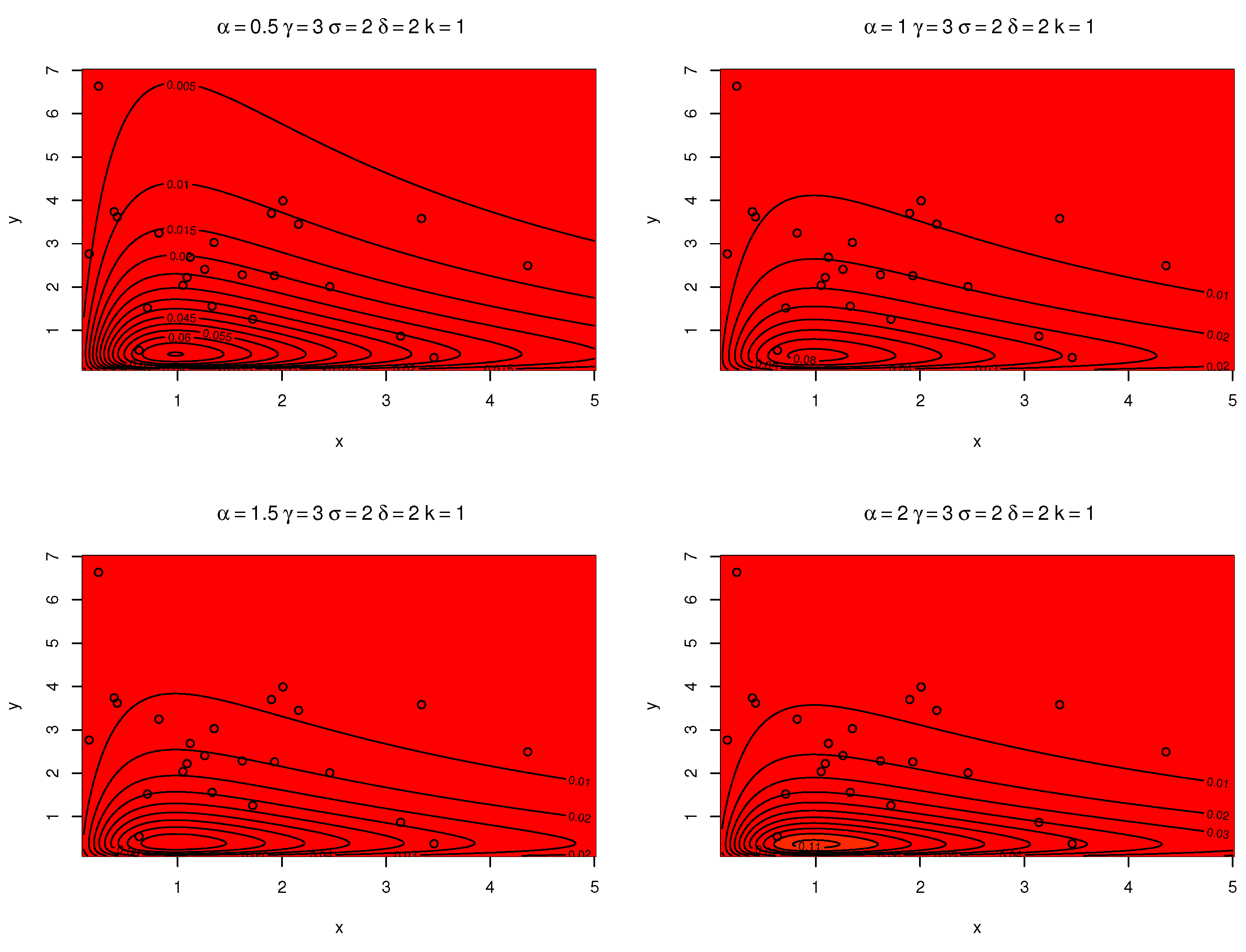

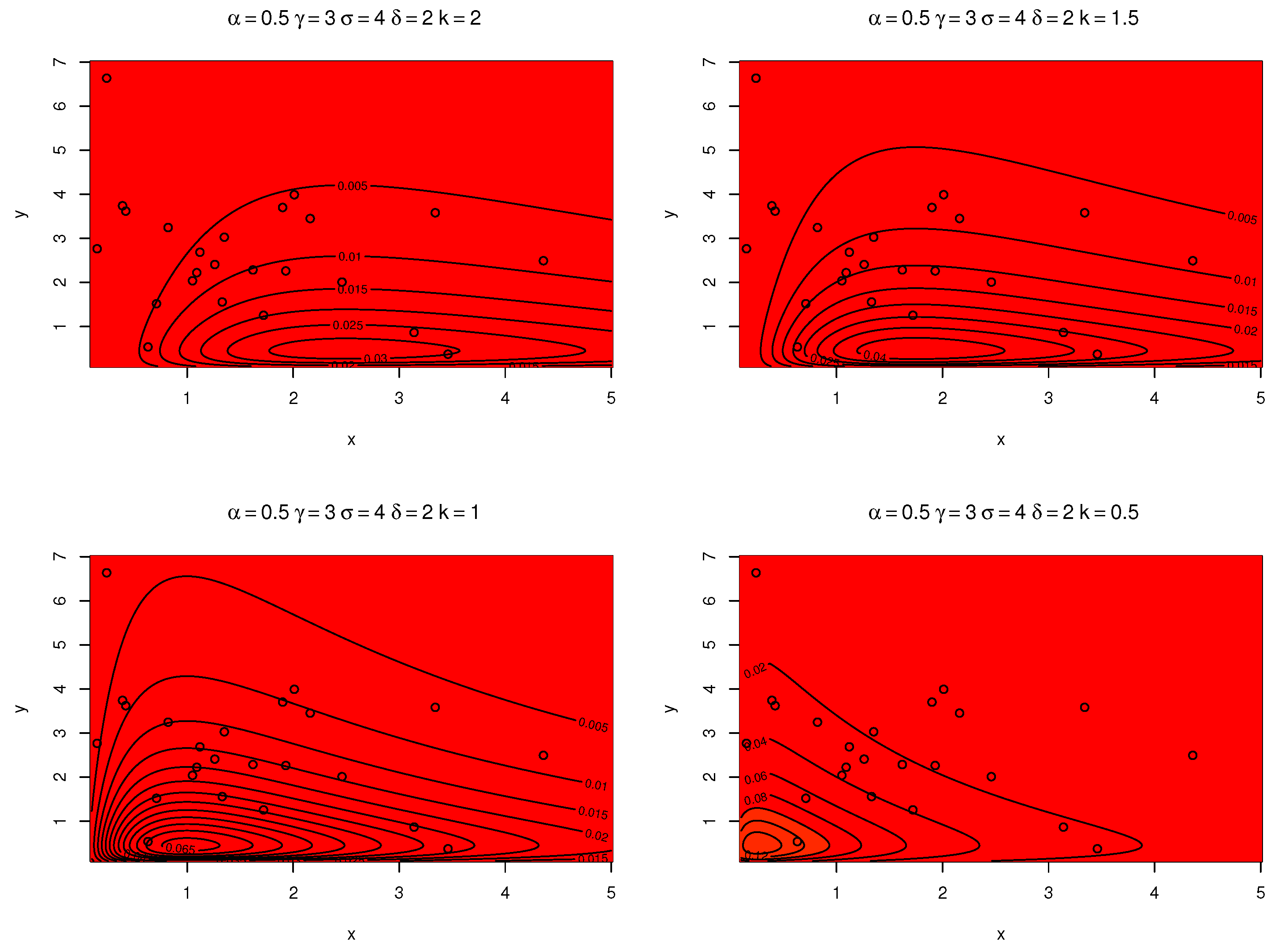
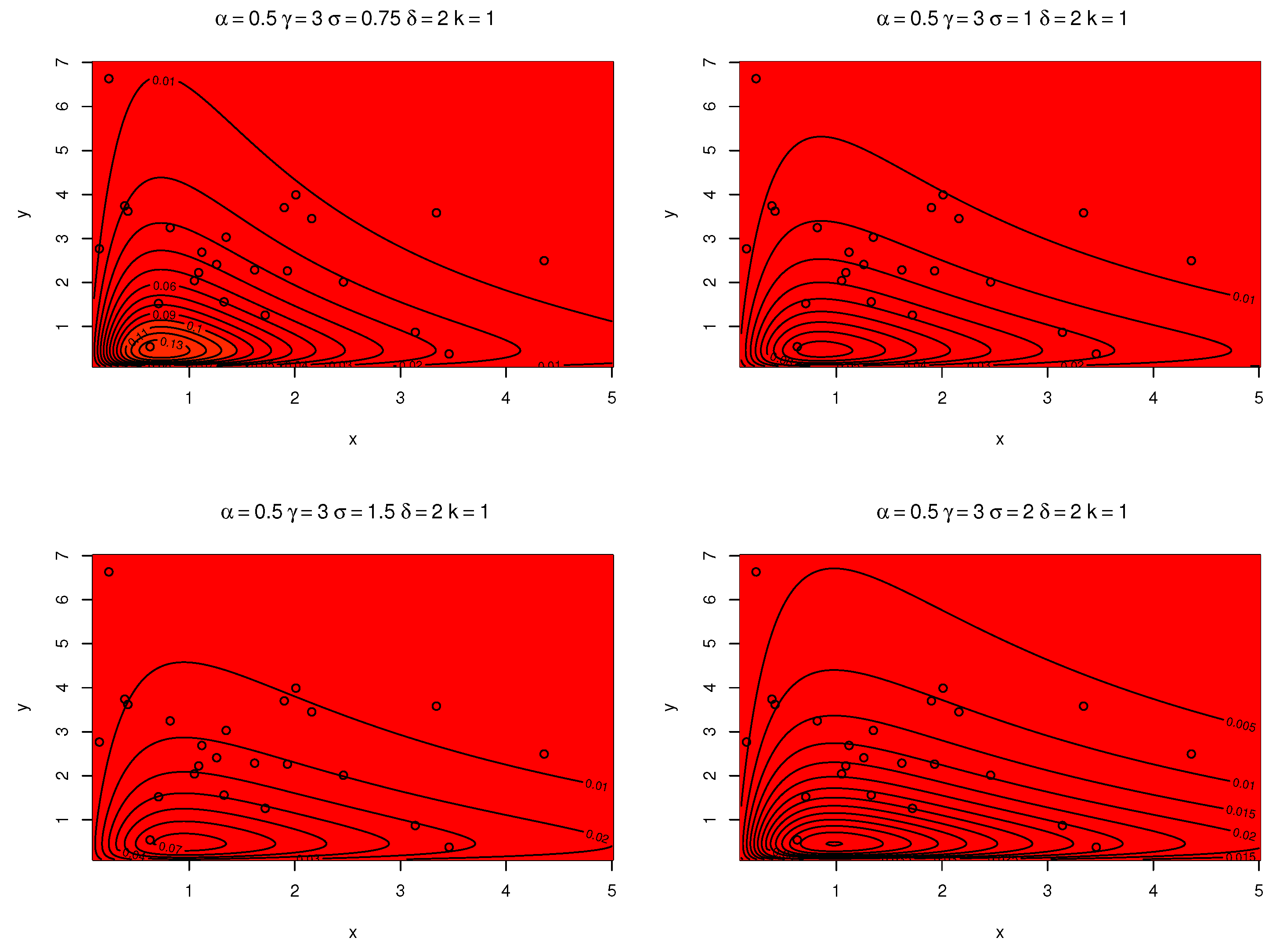
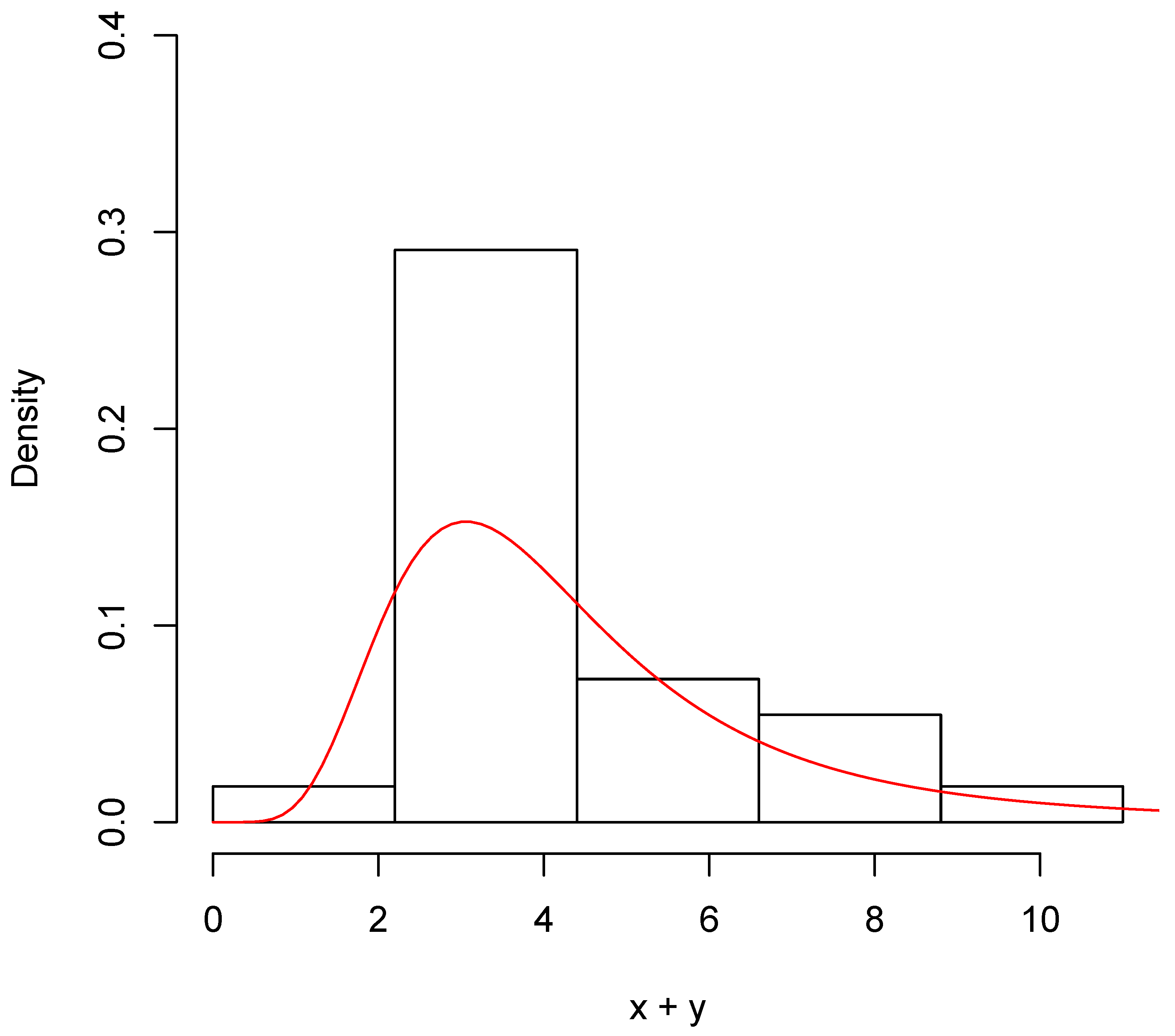
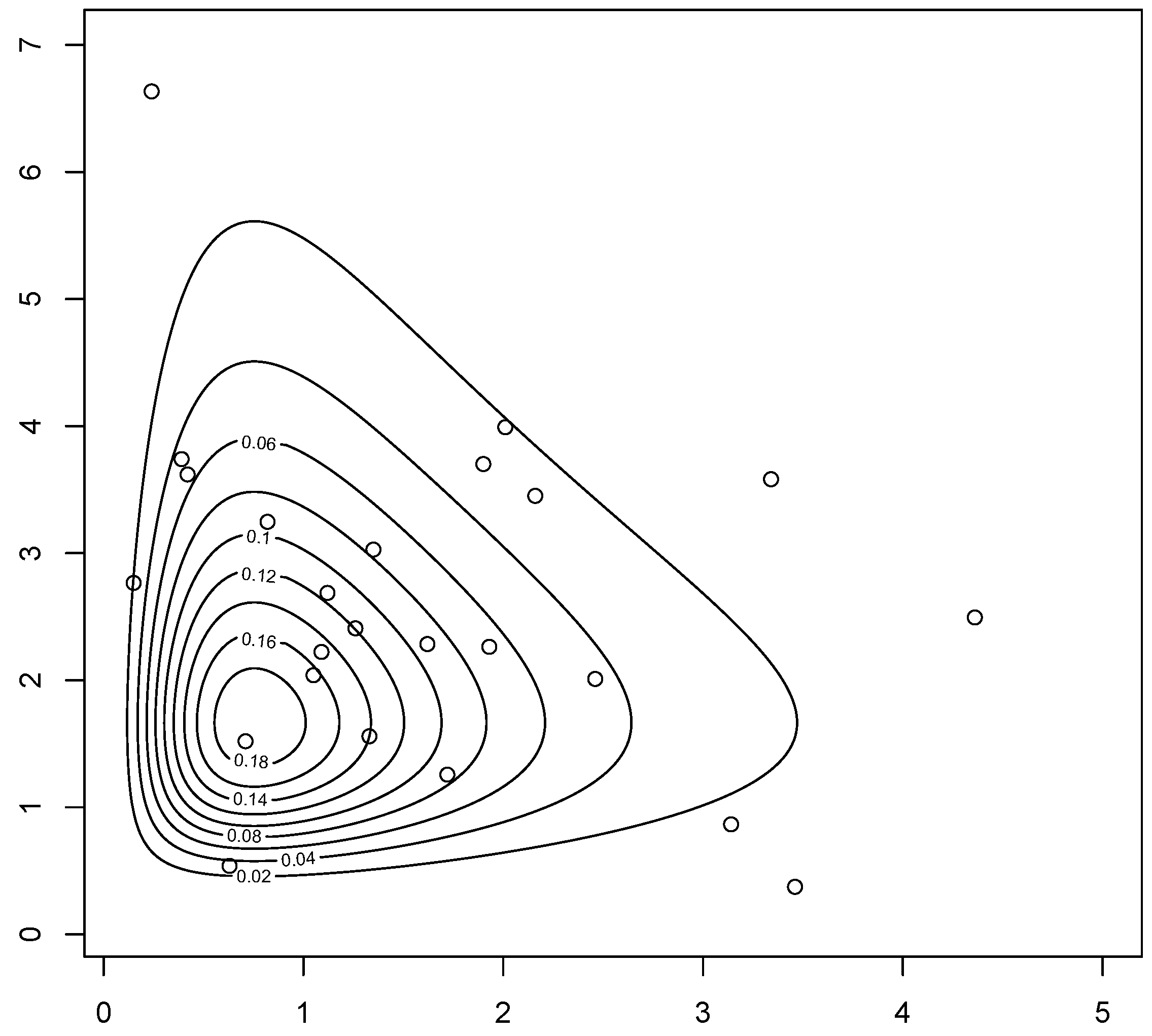
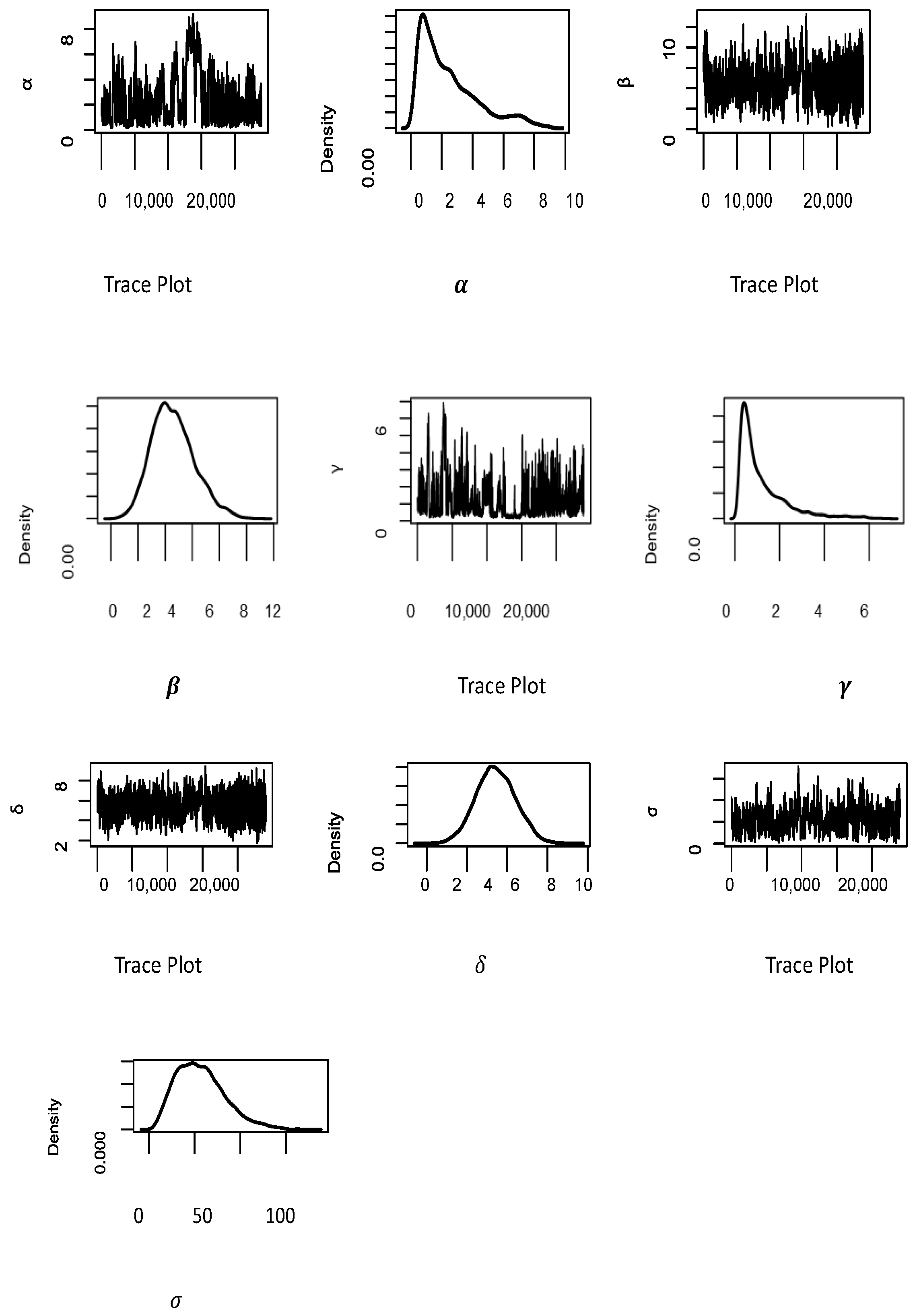
| Parameter | Estimate | Std. Error |
|---|---|---|
| 2.2338 | 8.9739 | |
| 7.3106 | 2.8615 | |
| 1.5520 | 6.2469 | |
| 6.5401 | 1.2143 | |
| 0.3471 | 1.4763 | |
| negative log likelihood | −84.95289 |
| Parameters | Mean | Median | S.D. | 25th Percentile | 75th Percentile | 95% CI |
|---|---|---|---|---|---|---|
| 3.1943 | 2.4371 | 2.3911 | 1.5710 | 4.0391 | 0.861–9.971 | |
| 4.5209 | 3.4703 | 1.5316 | 3.4703 | 5.4544 | 1.781–7.795 | |
| 0.7314 | 0.6402 | 0.4271 | 0.3943 | 0.9843 | 0.170–1.753 | |
| 5.3925 | 5.4016 | 0.9523 | 4.7636 | 6.0232 | 3.50–7.24 | |
| 63.9082 | 60.4044 | 30.9696 | 41.6535 | 79.0033 | 19.107–156.206 |
Disclaimer/Publisher’s Note: The statements, opinions and data contained in all publications are solely those of the individual author(s) and contributor(s) and not of MDPI and/or the editor(s). MDPI and/or the editor(s) disclaim responsibility for any injury to people or property resulting from any ideas, methods, instructions or products referred to in the content. |
© 2023 by the authors. Licensee MDPI, Basel, Switzerland. This article is an open access article distributed under the terms and conditions of the Creative Commons Attribution (CC BY) license (https://creativecommons.org/licenses/by/4.0/).
Share and Cite
Farooq, M.; Gul, A.; Alshanbari, H.M.; Khosa, S.K. Modeling of System Availability and Bayesian Analysis of Bivariate Distribution. Symmetry 2023, 15, 1698. https://doi.org/10.3390/sym15091698
Farooq M, Gul A, Alshanbari HM, Khosa SK. Modeling of System Availability and Bayesian Analysis of Bivariate Distribution. Symmetry. 2023; 15(9):1698. https://doi.org/10.3390/sym15091698
Chicago/Turabian StyleFarooq, Muhammad, Ahtasham Gul, Huda M. Alshanbari, and Saima K. Khosa. 2023. "Modeling of System Availability and Bayesian Analysis of Bivariate Distribution" Symmetry 15, no. 9: 1698. https://doi.org/10.3390/sym15091698






